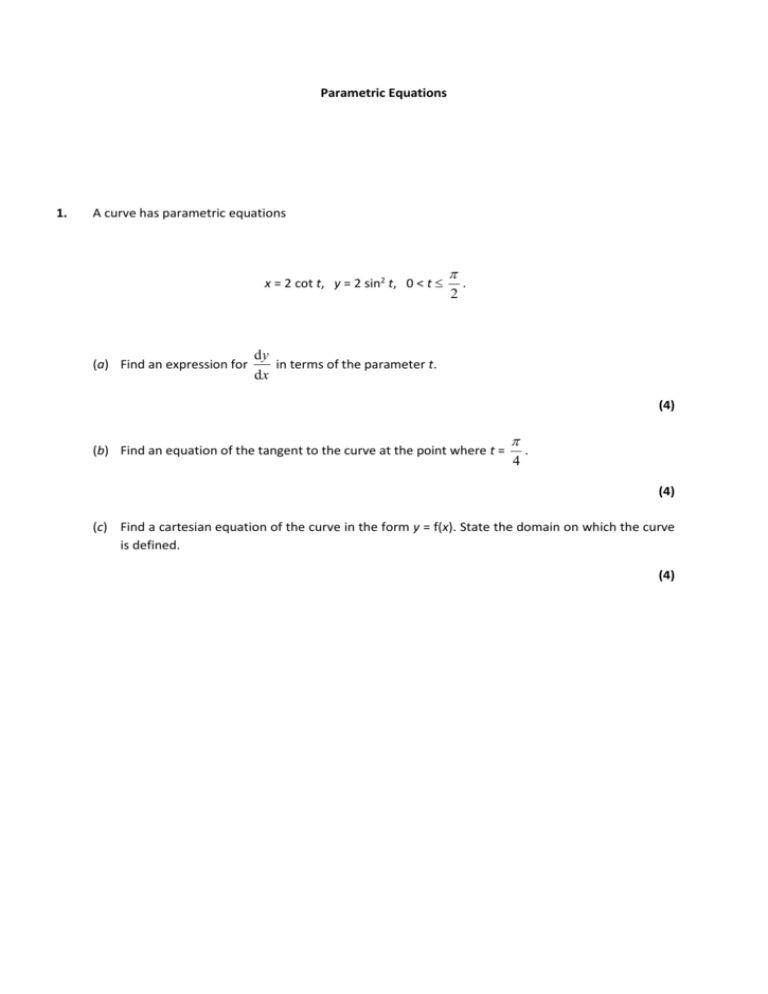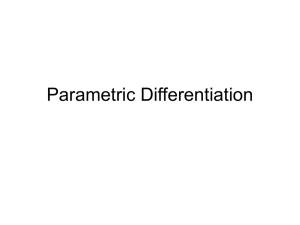Parametric Equations 1. A curve has parametric equations x = 2 cot t
advertisement

Parametric Equations 1. A curve has parametric equations x = 2 cot t, y = 2 sin2 t, 0 < t (a) Find an expression for . 2 dy in terms of the parameter t. dx (4) (b) Find an equation of the tangent to the curve at the point where t = . 4 (4) (c) Find a cartesian equation of the curve in the form y = f(x). State the domain on which the curve is defined. (4) 2. Figure 1 Y P C R O Q x Figure 1 shows a sketch of part of the curve C with parametric equations x = t2 + 1, y = 3(1 + t). The normal to C at the point P(5, 9) cuts the x-axis at the point Q, as shown in Figure 1. (a) Find the x-coordinate of Q. (6) (b) Find the area of the finite region R bounded by C, the line PQ and the x-axis. (9 3. Figure 1 y C O 2 3 1 x The curve C has parametric equations x= 1 1 , y= , t < 1. 1 t 1 t (a) Find an equation for the tangent to C at the point where t = 1 2 . (7) (b) Show that C satisfies the cartesian equation y = x . 2x 1 (3) The finite region between the curve C and the x-axis, bounded by the lines with equations x = 2 3 and x = 1, is shown shaded in Figure 1. (c) Calculate the exact value of the area of this region, giving your answer in the form a + b ln c, where a, b and c are constants. (6) 4. Figure 1 y 1 2 a A B O a The curve shown in Figure 1 has parametric equations x = a cos 3t, y = a sin t, 0t . 6 The curve meets the axes at points A and B as shown in Figure 1. x The straight line shown is part of the tangent to the curve at the point A. Find, in terms of a, (a) an equation of the tangent at A, (6) (b) an exact value for the area of the finite region between the curve, the tangent at A and the x-axis, shown shaded in Figure 1. (9) 5. Figure 2 y 0.5 –1 –0.5 O 0.5 1 x The curve shown in Figure 2 has parametric equations x = sin t, y = sin t , 6 2 <t< . 2 (a) Find an equation of the tangent to the curve at the point where t = . 6 (6) (b) Show that a cartesian equation of the curve is y= 1 3 x + (1 – x2), 2 2 –1 < x < 1. (3) Question Number 1. Scheme Marks dx dy 2 cosec 2 t , 4sin t cos t dt dt (a) M1 A1 both d y 2sin t cos t dx cosec 2 t 2sin 3 t cos t M1 A1 (4) At t 4 , x 2, y 1 (b) B1 both x and y Substitutes t 4 into an attempt at dy to obtain gradient dx M1 1 2 Equation of tangent is y 1 1 x 2 2 M1 A1 Accept x 2 y 4 or any (4) correct equivalent (c) t Uses 1 cot 2 t cosec 2 t , or equivalent, to eliminate M1 2 2 x 1 y 2 A1 correctly eliminates t y 8 4 x2 A1 cao B1 (4) The domain is x …0 [12] An alternative in (c) 1 1 x x y 2 y 2 sin t ; cos t sin t 2 2 2 2 sin t cos t 1 2 2 y x2 y 1 2 4 2 Leading to y 8 4 x2 M1 A1 A1 2. Question Number Scheme Marks _______ ___________________________________________________________________ __________ 3. (a) dx 1 dt (1 t ) 2 and B1, B1 dy 1 dt (1 t ) 2 dy (1 t )2 and at t = ½, gradient is –9 dx (1 t )2 M1 requires their dy/dt / their dx/dt M1 A1cao and substitution of t. At the point of contact x = (b) 2 3 B1 and y =2 Equation is y – 2 = -9 ( x - 23 ) M1 A1 1 1 (or both) 1 or t 1 x y Then substitute into other expression y = f(x) or x = g(y) and rearrange 1 1 (or put 1 1 and rearrange) x y x To obtain y * 2x 1 M1 (7) Either obtain t in terms of x and y i,e, t 1 x (1 t ) Or Substitute into 2 2x 1 1 1 t 1 1 = 2 (1 t ) 1 t = y * (c) 1 Area = M1 A1 (3) M1 A1 M1 (3) x 2 x 1dx B1 2 3 u 1 du 1 = 1 u1 du 2u 2 4 1 1 1 = 4 u 4 ln u 1 = putting into a form to integrate M1 M1 A1 3 ( 121 14 ln 13 ) 1 1 = ln 3 or any correct equivalent. 6 4 = 1 4 M1 A1 (6) Question Number 4(a) Scheme dx 3a sin 3t , dt 6 3 Gradient is 6 dy a cos t dt therefore Marks dy cos t dx 3sin 3t B1 When x = 0, t = M1 Line equation is ( y 12 a ) (b) Area beneath curve is 3 ( x 0) 6 M1 A1 a sin t (3a sin 3t )dt 3a 2 (cos 2t cos 4t )dt 2 3a 2 1 1 2 sin 2t 4 sin 4t 2 3 3a 2 Uses limits 0 and to give 16 6 1 a Area of triangle beneath tangent is 3a = 2 2 2 3a 3 3a 2 3a 2 Thus required area is = 16 4 16 M1 M1 = N.B. M1 A1 M1 A1 M1 A1 3a 2 4 M1 A1 A1 The integration of the product of two sines is worth 3 marks (lines 2 and 3 of scheme to part (b)) If they use parts sin t sin 3tdt cos t sin 3t 3cos 3t cos tdt cos t sin 3t 3cos 3t sin t 9sin 3t sin tdt 8I = cost sin3t – 3 cos3t sint M1 M1 A1







